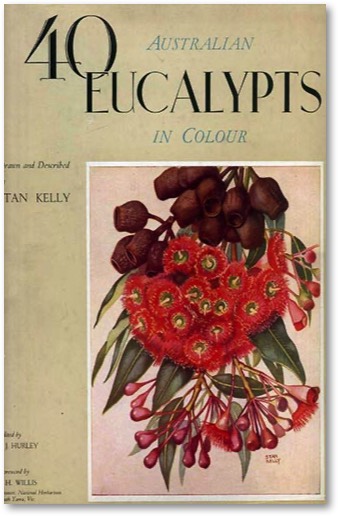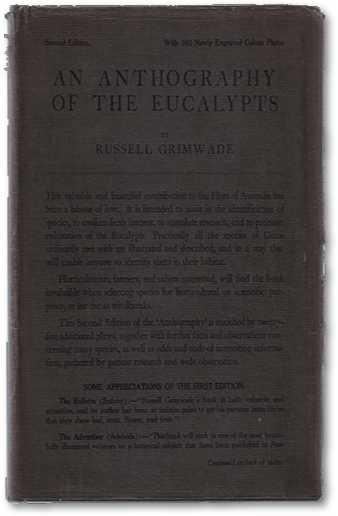
Articles » Eucalyptus: musing on many species


Kelly, Stan
Dymocks Book Arcade 1949
Dymocks Book Arcade 1949

Grimed, Russell
Angus & Robertson Limited 1920
The eucalyptus is the tree everyone loves to hate but I do not think that most people have any idea about the fantastic number of species in the eucalyptus genus and the fact that at least one variety is utterly heavenly in our streets. Eucalyptus ficifolia, Flowering Red Gum, presides with stately grace over many streets and public spaces, drawing excited comments from visitors who have never seen it before.
This is not the eucalyptus of popular horror stories, the invader elbowing out our precious native trees. The club’s library has two books about eucalyptus, 40 Australian Eucalypts in Colour by Stan Kelly, published in 1949 and An Anthography of the Eucalypts by Russell Grimwade, published in 1920. Anthography is a curious word which I had to look up in the dictionary. It means a scientific discussion of flowers.
Kelly’s book has handsome coloured plates, Grimwade’s monochromatic illustrations in shades of green. These two books complement each other, one with its precise technical detail, the other with its equally accurate text but lush, almost romantic paintings. Kelly was primarily an artist.
The genus was named by L’Herétier, the French taxonomist, in 1788. This is the man who discovered Redouté and helped him become a great master painter of flowers. Eucalyptus is derived from two Greek terms: eu means “well” and kalyptos means “covered”. L’Herétier noticed the dominant feature of all the specimens he saw was the little lid which kept the flower covered.
There are approximately 250 species of this tree, confined essentially to Australia and Tasmania. It forms almost three quarters of the original forest there. The ordinary names range very widely. Some of them are native words, such as “moort” and “yate”, and perhaps “muttlegar”, others were bestowed by British convicts and early settlers: “blue gum”, and “sugar gum”. The flowers come in many shades, from yellow to red, with contrasting fruits of black or burgundy.
Seldom has a group of trees done more for the dwellers in an ancient land than the Eucalyptus: timber, shelter, drainage, honey and the wonderful oil stored in the leaves which formed the basis of many cough medicines. It is hardly surprising that horticulutral experts in California should have wanted to encourage their planting in our arid state which resembles the outback of Australia to some extent.
Take a look at Kelly’s book and decide whether you really want to kick the next eucalyptus tree you see.
This is not the eucalyptus of popular horror stories, the invader elbowing out our precious native trees. The club’s library has two books about eucalyptus, 40 Australian Eucalypts in Colour by Stan Kelly, published in 1949 and An Anthography of the Eucalypts by Russell Grimwade, published in 1920. Anthography is a curious word which I had to look up in the dictionary. It means a scientific discussion of flowers.
Kelly’s book has handsome coloured plates, Grimwade’s monochromatic illustrations in shades of green. These two books complement each other, one with its precise technical detail, the other with its equally accurate text but lush, almost romantic paintings. Kelly was primarily an artist.
The genus was named by L’Herétier, the French taxonomist, in 1788. This is the man who discovered Redouté and helped him become a great master painter of flowers. Eucalyptus is derived from two Greek terms: eu means “well” and kalyptos means “covered”. L’Herétier noticed the dominant feature of all the specimens he saw was the little lid which kept the flower covered.
There are approximately 250 species of this tree, confined essentially to Australia and Tasmania. It forms almost three quarters of the original forest there. The ordinary names range very widely. Some of them are native words, such as “moort” and “yate”, and perhaps “muttlegar”, others were bestowed by British convicts and early settlers: “blue gum”, and “sugar gum”. The flowers come in many shades, from yellow to red, with contrasting fruits of black or burgundy.
Seldom has a group of trees done more for the dwellers in an ancient land than the Eucalyptus: timber, shelter, drainage, honey and the wonderful oil stored in the leaves which formed the basis of many cough medicines. It is hardly surprising that horticulutral experts in California should have wanted to encourage their planting in our arid state which resembles the outback of Australia to some extent.
Take a look at Kelly’s book and decide whether you really want to kick the next eucalyptus tree you see.

